Attached files
| file | filename |
|---|---|
| 8-K - 8-K - PennyMac Mortgage Investment Trust | pmt-8k_20200915.htm |
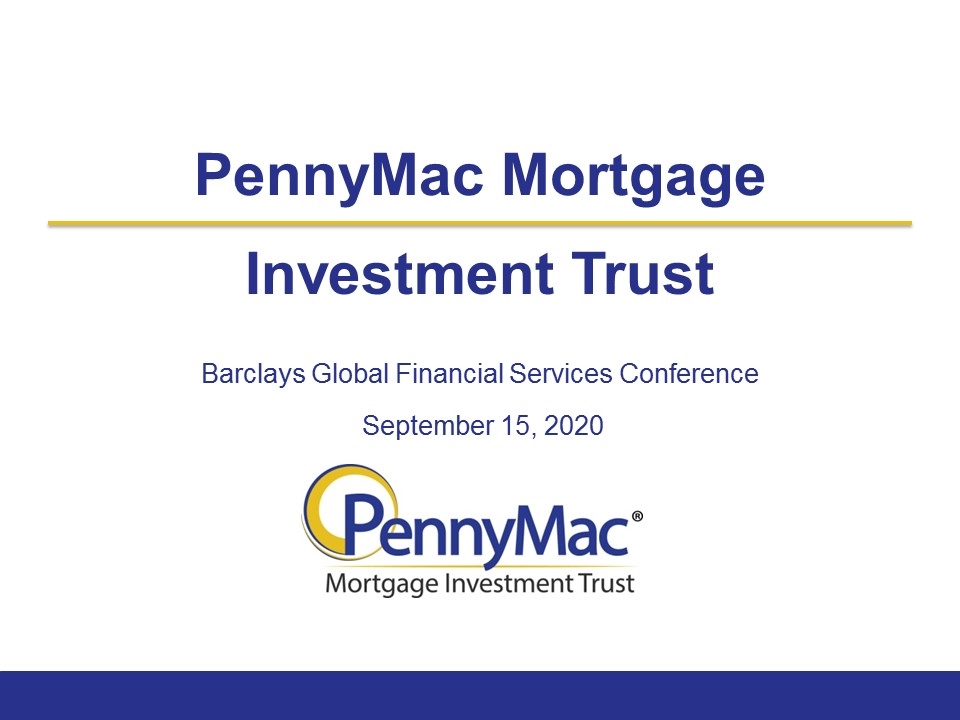
PennyMac Mortgage Investment Trust September 15, 2020 Barclays Global Financial Services Conference

Forward-Looking Statements 2020 Barclays Global Financial Services Conference This presentation contains forward-looking statements within the meaning of Section 21E of the Securities Exchange Act of 1934, as amended, regarding management’s beliefs, estimates, projections and assumptions with respect to, among other things, the Company’s financial results, future operations, business plans and investment strategies, as well as industry and market conditions, all of which are subject to change. Words like “believe,” “expect,” “anticipate,” “promise,” “project,” “plan,” and other expressions or words of similar meanings, as well as future or conditional verbs such as “will,” “would,” “should,” “could,” or “may” are generally intended to identify forward-looking statements. Actual results and operations for any future period may vary materially from those projected herein, from past results discussed herein, or illustrative examples provided herein. These forward-looking statements include, but are not limited to, statements regarding the future impact of COVID-19 on our business, financial operations and our GSE credit risk transfer (CRT) investments, future loan delinquencies and forbearances , projected servicing advances requirements, future CRT investment returns, losses and outlooks, future investment strategies and other business and financial expectations. Factors which could cause actual results to differ materially from historical results or those anticipated include, but are not limited to: our exposure to risks of loss and disruptions in operations resulting from adverse weather conditions, man-made or natural disasters, climate change and pandemics such as COVID-19; the impact to our CRT agreements of increased borrower requests for forbearance under the CARES Act; changes in our investment objectives or investment or operational strategies, including any new lines of business or new products and services that may subject us to additional risks; volatility in our industry, the debt or equity markets, the general economy or the real estate finance and real estate markets specifically, whether the result of market events or otherwise; events or circumstances which undermine confidence in the financial markets or otherwise have a broad impact on financial markets, such as the sudden instability or collapse of large depository institutions or other significant corporations, terrorist attacks, natural or man-made disasters, or threatened or actual armed conflicts; changes in general business, economic, market, employment and political conditions, or in consumer confidence and spending habits from those expected; declines in real estate or significant changes in U.S. housing prices or activity in the U.S. housing market; the availability of, and level of competition for, attractive risk-adjusted investment opportunities in mortgage loans and mortgage-related assets that satisfy our investment objectives; the inherent difficulty in winning bids to acquire mortgage loans, and our success in doing so; the concentration of credit risks to which we are exposed; the degree and nature of our competition; our dependence on our manager and servicer, potential conflicts of interest with such entities and their affiliates, and the performance of such entities; changes in personnel and lack of availability of qualified personnel at our manager, servicer or their affiliates; the availability, terms and deployment of short-term and long-term capital; the adequacy of our cash reserves and working capital; our ability to maintain the desired relationship between our financing and the interest rates and maturities of our assets; the timing and amount of cash flows, if any, from our investments; unanticipated increases or volatility in financing and other costs, including a rise in interest rates; the performance, financial condition and liquidity of borrowers; the ability of our servicer, which also provides us with fulfillment services, to approve and monitor correspondent sellers and underwrite loans to investor standards; incomplete or inaccurate information or documentation provided by customers or counterparties, or adverse changes in the financial condition of our customers and counterparties; our indemnification and repurchase obligations in connection with mortgage loans we purchase and later sell or securitize; the quality and enforceability of the collateral documentation evidencing our ownership and rights in the assets in which we invest; increased rates of delinquency, default and/or decreased recovery rates on our investments; our ability to foreclose on our investments in a timely manner or at all; increased prepayments of the mortgages and other loans underlying our mortgage-backed securities or relating to our mortgage servicing rights , excess servicing spread and other investments; the degree to which our hedging strategies may or may not protect us from interest rate volatility; the effect of the accuracy of or changes in the estimates we make about uncertainties, contingencies and asset and liability valuations when measuring and reporting upon our financial condition and results of income; our failure to maintain appropriate internal controls over financial reporting; technologies for loans and our ability to mitigate security risks and cyber intrusions; our ability to obtain and/or maintain licenses and other approvals in those jurisdictions where required to conduct our business; our ability to detect misconduct and fraud; our ability to comply with various federal, state and local laws and regulations that govern our business; developments in the secondary markets for our mortgage loan products; legislative and regulatory changes that impact the mortgage loan industry or housing market; changes in regulations or the occurrence of other events that impact the business, operations or prospects of government agencies or government-sponsored entities, or such changes that increase the cost of doing business with such entities; the Dodd-Frank Wall Street Reform and Consumer Protection Act and its implementing regulations and regulatory agencies, and any other legislative and regulatory changes that impact the business, operations or governance of mortgage lenders and/or publicly-traded companies; the Consumer Financial Protection Bureau and its issued and future rules and the enforcement thereof; changes in government support of homeownership; changes in government or government-sponsored home affordability programs; limitations imposed on our business and our ability to satisfy complex rules for us to qualify as a real estate investment trust (REIT) for U.S. federal income tax purposes and qualify for an exclusion from the Investment Company Act of 1940 and the ability of certain of our subsidiaries to qualify as REITs or as taxable REIT subsidiaries for U.S. federal income tax purposes, as applicable, and our ability and the ability of our subsidiaries to operate effectively within the limitations imposed by these rules; changes in governmental regulations, accounting treatment, tax rates and similar matters (including changes to laws governing the taxation of REITs, or the exclusions from registration as an investment company); the effect of public opinion on our reputation and our organizational structure and certain requirements in our charter documents. You should not place undue reliance on any forward-looking statement and should consider all of the uncertainties and risks described above, as well as those more fully discussed in reports and other documents filed by the Company with the Securities and Exchange Commission from time to time. The Company undertakes no obligation to publicly update or revise any forward-looking statements or any other information contained herein, and the statements made in this presentation are current as of the date of this presentation only.
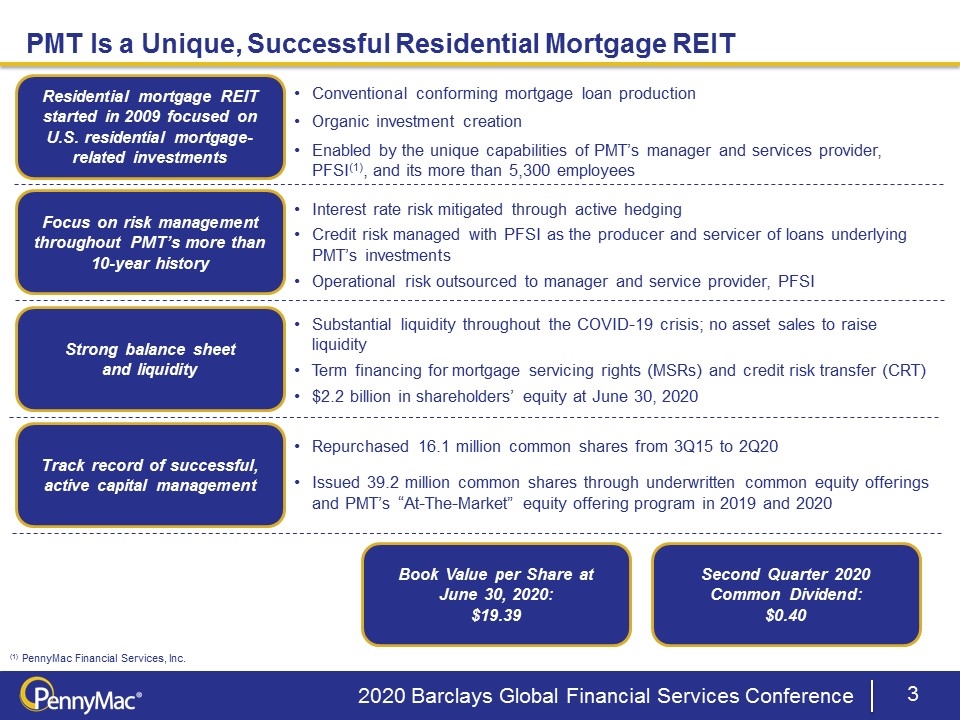
2020 Barclays Global Financial Services Conference PMT Is a Unique, Successful Residential Mortgage REIT Residential mortgage REIT started in 2009 focused on U.S. residential mortgage-related investments Focus on risk management throughout PMT’s more than 10-year history Track record of successful, active capital management Strong balance sheet and liquidity (1) PennyMac Financial Services, Inc. Conventional conforming mortgage loan production Organic investment creation Enabled by the unique capabilities of PMT’s manager and services provider, PFSI(1), and its more than 5,300 employees Repurchased 16.1 million common shares from 3Q15 to 2Q20 Issued 39.2 million common shares through underwritten common equity offerings and PMT’s “At-The-Market” equity offering program in 2019 and 2020 Substantial liquidity throughout the COVID-19 crisis; no asset sales to raise liquidity Term financing for mortgage servicing rights (MSRs) and credit risk transfer (CRT) $2.2 billion in shareholders’ equity at June 30, 2020 Interest rate risk mitigated through active hedging Credit risk managed with PFSI as the producer and servicer of loans underlying PMT’s investments Operational risk outsourced to manager and service provider, PFSI Book Value per Share at June 30, 2020: $19.39 Second Quarter 2020 Common Dividend: $0.40
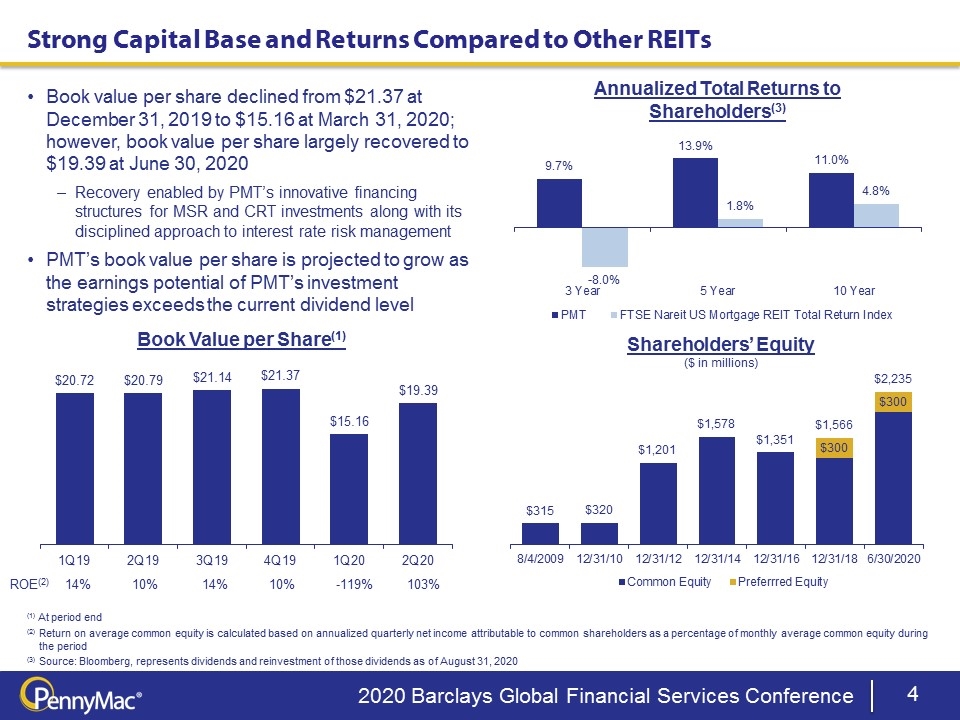
ROE(2) 14% 10% 14% 10% -119% 103% Book Value per Share(1) Shareholders’ Equity ($ in millions) Book value per share declined from $21.37 at December 31, 2019 to $15.16 at March 31, 2020; however, book value per share largely recovered to $19.39 at June 30, 2020 Recovery enabled by PMT’s innovative financing structures for MSR and CRT investments along with its disciplined approach to interest rate risk management PMT’s book value per share is projected to grow as the earnings potential of PMT’s investment strategies exceeds the current dividend level 2020 Barclays Global Financial Services Conference Strong Capital Base and Returns Compared to Other REITs (1) At period end (2) Return on average common equity is calculated based on annualized quarterly net income attributable to common shareholders as a percentage of monthly average common equity during the period (3) Source: Bloomberg, represents dividends and reinvestment of those dividends as of August 31, 2020 Annualized Total Returns to Shareholders(3)
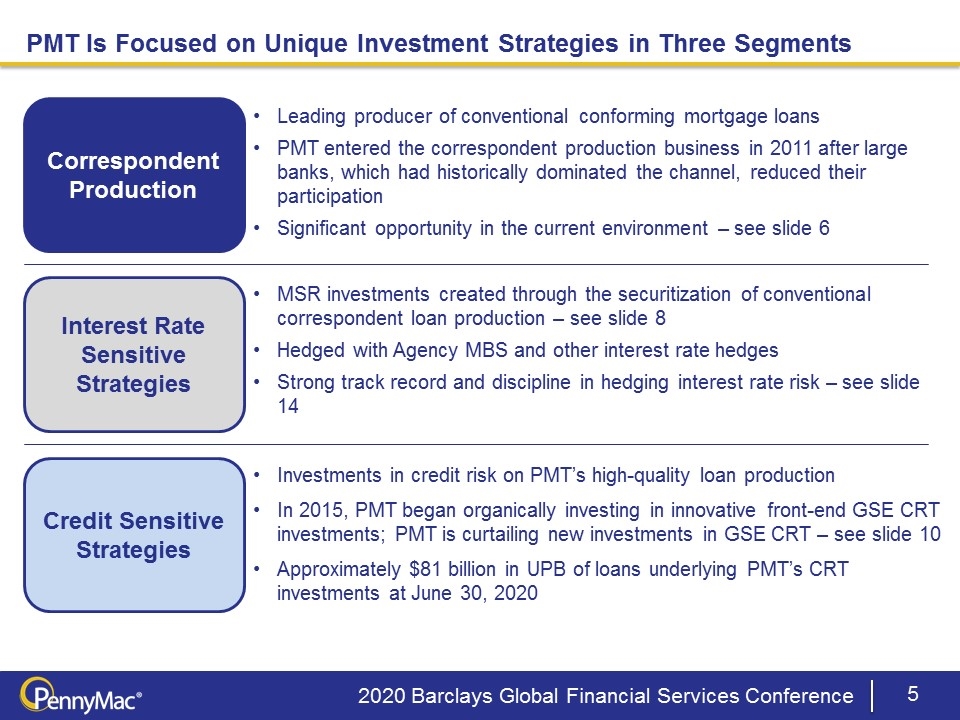
2020 Barclays Global Financial Services Conference PMT Is Focused on Unique Investment Strategies in Three Segments Correspondent Production Credit Sensitive Strategies Interest Rate Sensitive Strategies Leading producer of conventional conforming mortgage loans PMT entered the correspondent production business in 2011 after large banks, which had historically dominated the channel, reduced their participation Significant opportunity in the current environment – see slide 6 Investments in credit risk on PMT’s high-quality loan production In 2015, PMT began organically investing in innovative front-end GSE CRT investments; PMT is curtailing new investments in GSE CRT – see slide 10 Approximately $81 billion in UPB of loans underlying PMT’s CRT investments at June 30, 2020 MSR investments created through the securitization of conventional correspondent loan production – see slide 8 Hedged with Agency MBS and other interest rate hedges Strong track record and discipline in hedging interest rate risk – see slide 14
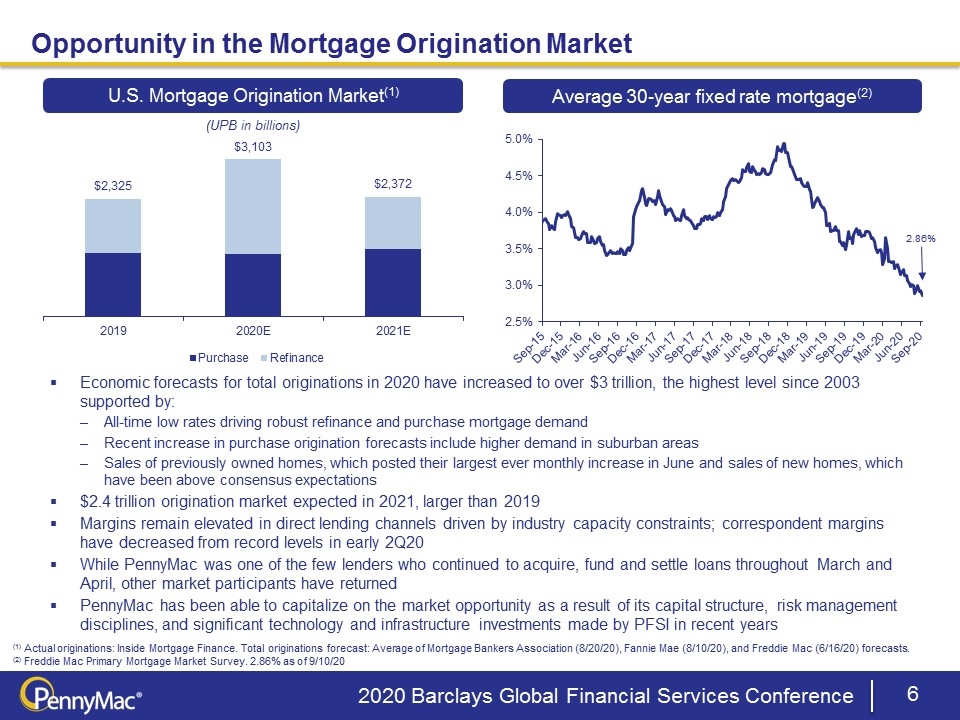
2020 Barclays Global Financial Services Conference Opportunity in the Mortgage Origination Market (1) Actual originations: Inside Mortgage Finance. Total originations forecast: Average of Mortgage Bankers Association (8/20/20), Fannie Mae (8/10/20), and Freddie Mac (6/16/20) forecasts. (2) Freddie Mac Primary Mortgage Market Survey. 2.86% as of 9/10/20 U.S. Mortgage Origination Market(1) (UPB in billions) Average 30-year fixed rate mortgage(2) Economic forecasts for total originations in 2020 have increased to over $3 trillion, the highest level since 2003 supported by: All-time low rates driving robust refinance and purchase mortgage demand Recent increase in purchase origination forecasts include higher demand in suburban areas Sales of previously owned homes, which posted their largest ever monthly increase in June and sales of new homes, which have been above consensus expectations $2.4 trillion origination market expected in 2021, larger than 2019 Margins remain elevated in direct lending channels driven by industry capacity constraints; correspondent margins have decreased from record levels in early 2Q20 While PennyMac was one of the few lenders who continued to acquire, fund and settle loans throughout March and April, other market participants have returned PennyMac has been able to capitalize on the market opportunity as a result of its capital structure, risk management disciplines, and significant technology and infrastructure investments made by PFSI in recent years 2.86%
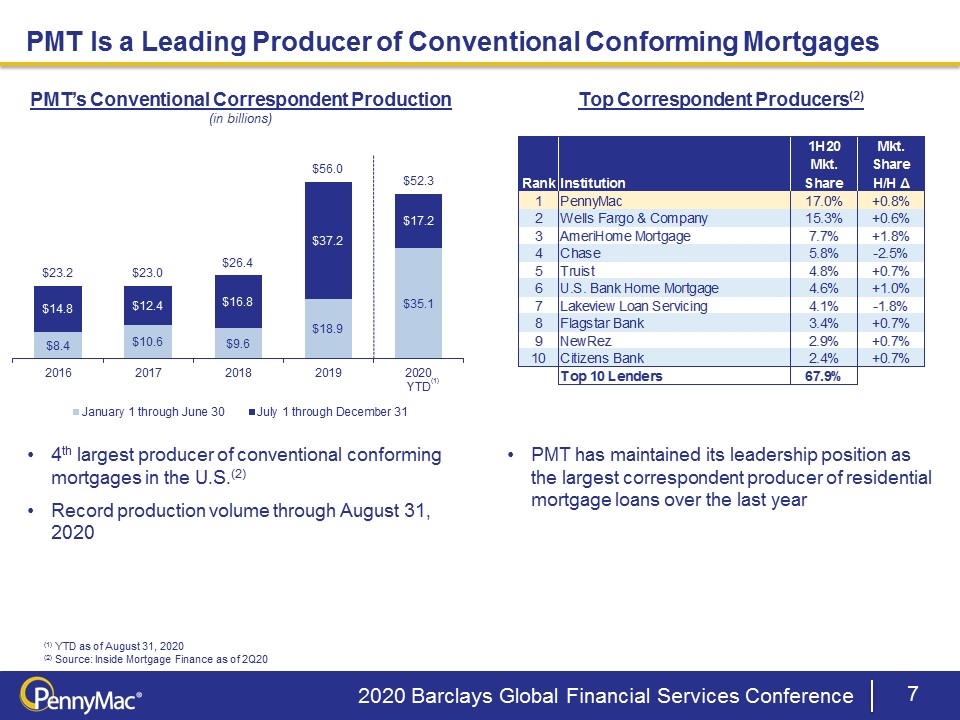
PMT Is a Leading Producer of Conventional Conforming Mortgages PMT’s Conventional Correspondent Production (in billions) Top Correspondent Producers(2) 4th largest producer of conventional conforming mortgages in the U.S.(2) Record production volume through August 31, 2020 PMT has maintained its leadership position as the largest correspondent producer of residential mortgage loans over the last year (1) YTD as of August 31, 2020 (2) Source: Inside Mortgage Finance as of 2Q20 2020 Barclays Global Financial Services Conference (1)
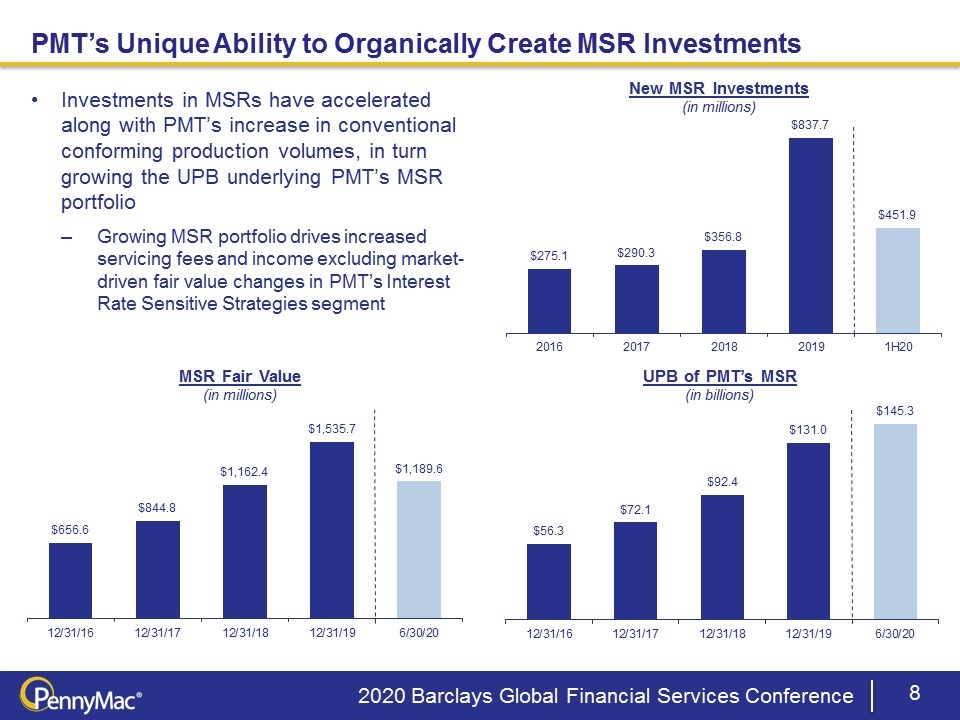
2020 Barclays Global Financial Services Conference PMT’s Unique Ability to Organically Create MSR Investments New MSR Investments (in millions) Investments in MSRs have accelerated along with PMT’s increase in conventional conforming production volumes, in turn growing the UPB underlying PMT’s MSR portfolio Growing MSR portfolio drives increased servicing fees and income excluding market-driven fair value changes in PMT’s Interest Rate Sensitive Strategies segment UPB of PMT’s MSR (in billions) MSR Fair Value (in millions)
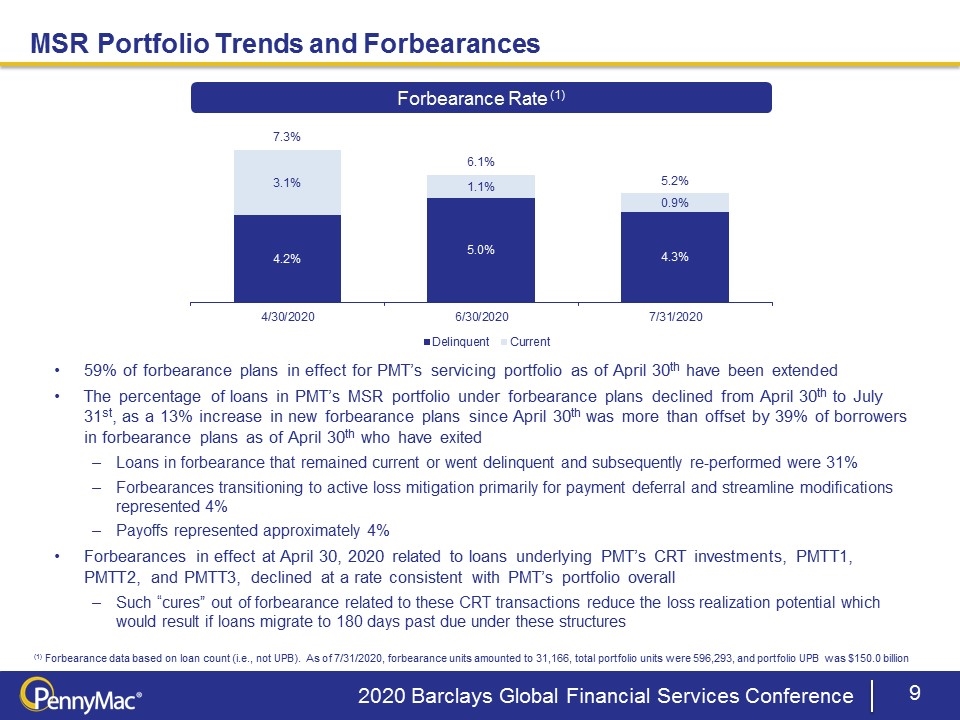
2020 Barclays Global Financial Services Conference MSR Portfolio Trends and Forbearances Forbearance Rate (1) (1) Forbearance data based on loan count (i.e., not UPB). As of 7/31/2020, forbearance units amounted to 31,166, total portfolio units were 596,293, and portfolio UPB was $150.0 billion 59% of forbearance plans in effect for PMT’s servicing portfolio as of April 30th have been extended The percentage of loans in PMT’s MSR portfolio under forbearance plans declined from April 30th to July 31st, as a 13% increase in new forbearance plans since April 30th was more than offset by 39% of borrowers in forbearance plans as of April 30th who have exited Loans in forbearance that remained current or went delinquent and subsequently re-performed were 31% Forbearances transitioning to active loss mitigation primarily for payment deferral and streamline modifications represented 4% Payoffs represented approximately 4% Forbearances in effect at April 30, 2020 related to loans underlying PMT’s CRT investments, PMTT1, PMTT2, and PMTT3, declined at a rate consistent with PMT’s portfolio overall Such “cures” out of forbearance related to these CRT transactions reduce the loss realization potential which would result if loans migrate to 180 days past due under these structures

2020 Barclays Global Financial Services Conference Overview of PMT's Investments in GSE Credit Risk Transfer (CRT) In alignment with the wind down of new investments in CRT, delivered $1.8 billion in UPB of loans in 2Q20 under our sixth transaction with Fannie Mae PennyMac’s strategy of owning the servicing relationship along with the credit risk on the loans it produces creates a strong alignment of interests and is instrumental in mitigating losses – see slide 11 Expected increase in realized losses has yet to materialize (1) The fair value of CRT investments is reflected on PMT’s balance sheet as deposits securing CRT arrangements, firm commitments to purchase CRT securities and derivative and credit risk transfer strip assets or liabilities, net of the interest-only security payable. Presented here on a pro forma basis that also includes the face amount of firm commitment to purchase CRT securities for each period shown. (2) FICO and LTV metrics at origination for the population of loans remaining as of the date presented CRT Investments(1) (in millions)
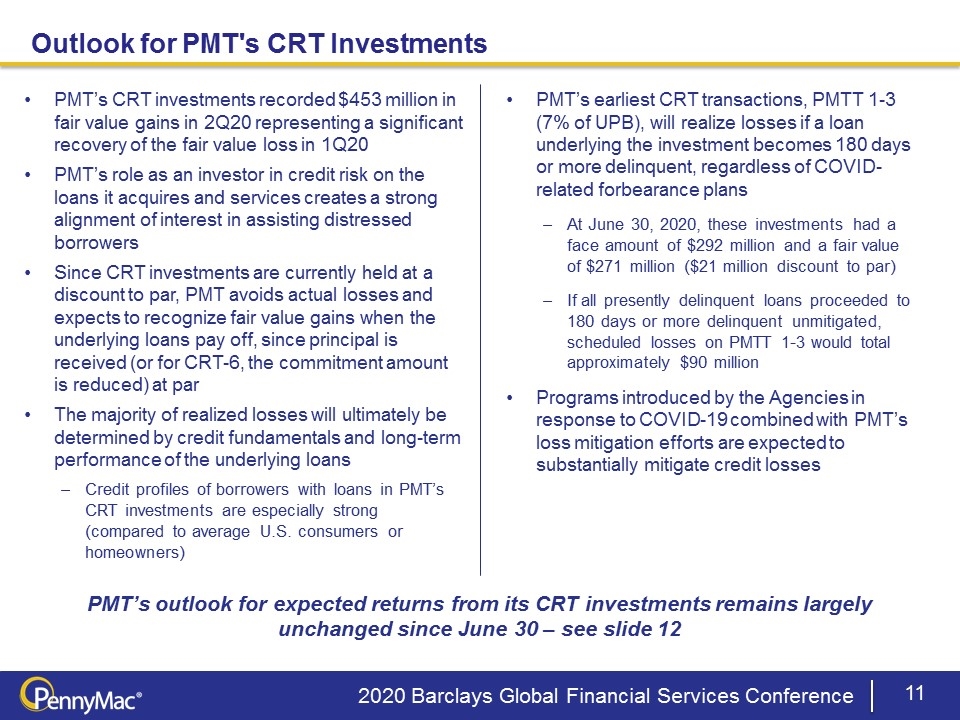
2020 Barclays Global Financial Services Conference Outlook for PMT's CRT Investments PMT’s CRT investments recorded $453 million in fair value gains in 2Q20 representing a significant recovery of the fair value loss in 1Q20 PMT’s role as an investor in credit risk on the loans it acquires and services creates a strong alignment of interest in assisting distressed borrowers Since CRT investments are currently held at a discount to par, PMT avoids actual losses and expects to recognize fair value gains when the underlying loans pay off, since principal is received (or for CRT-6, the commitment amount is reduced) at par The majority of realized losses will ultimately be determined by credit fundamentals and long-term performance of the underlying loans Credit profiles of borrowers with loans in PMT’s CRT investments are especially strong (compared to average U.S. consumers or homeowners) PMT’s outlook for expected returns from its CRT investments remains largely unchanged since June 30 – see slide 12 PMT’s earliest CRT transactions, PMTT 1-3 (7% of UPB), will realize losses if a loan underlying the investment becomes 180 days or more delinquent, regardless of COVID-related forbearance plans At June 30, 2020, these investments had a face amount of $292 million and a fair value of $271 million ($21 million discount to par) If all presently delinquent loans proceeded to 180 days or more delinquent unmitigated, scheduled losses on PMTT 1-3 would total approximately $90 million Programs introduced by the Agencies in response to COVID-19 combined with PMT’s loss mitigation efforts are expected to substantially mitigate credit losses
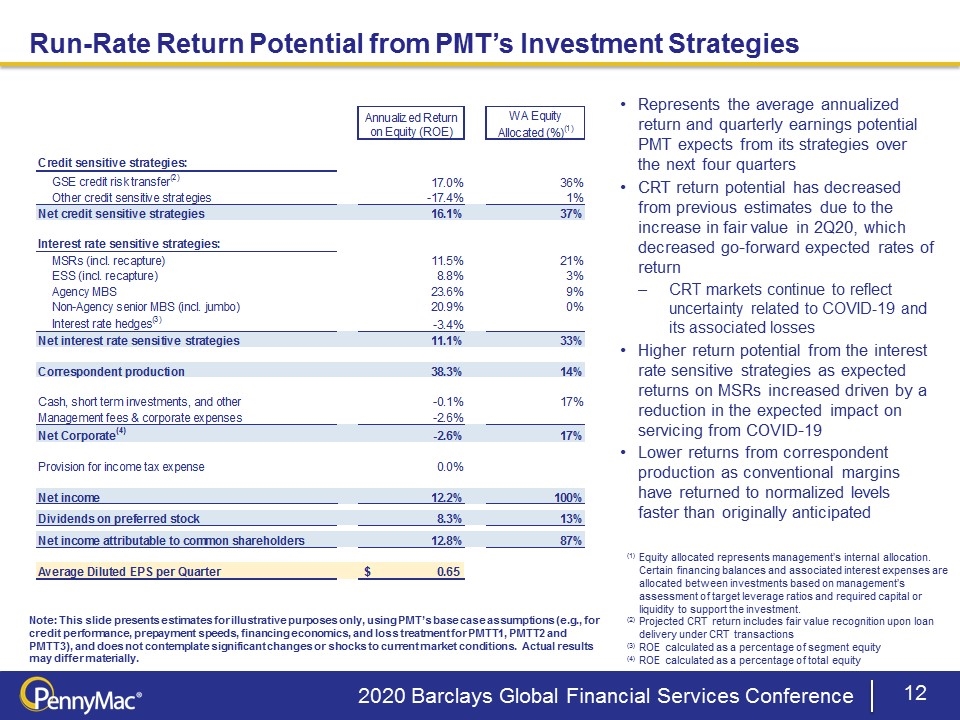
2020 Barclays Global Financial Services Conference Run-Rate Return Potential from PMT’s Investment Strategies Note: This slide presents estimates for illustrative purposes only, using PMT’s base case assumptions (e.g., for credit performance, prepayment speeds, financing economics, and loss treatment for PMTT1, PMTT2 and PMTT3), and does not contemplate significant changes or shocks to current market conditions. Actual results may differ materially. (1) Equity allocated represents management’s internal allocation. Certain financing balances and associated interest expenses are allocated between investments based on management’s assessment of target leverage ratios and required capital or liquidity to support the investment. (2) Projected CRT return includes fair value recognition upon loan delivery under CRT transactions (3) ROE calculated as a percentage of segment equity (4) ROE calculated as a percentage of total equity Represents the average annualized return and quarterly earnings potential PMT expects from its strategies over the next four quarters CRT return potential has decreased from previous estimates due to the increase in fair value in 2Q20, which decreased go-forward expected rates of return CRT markets continue to reflect uncertainty related to COVID-19 and its associated losses Higher return potential from the interest rate sensitive strategies as expected returns on MSRs increased driven by a reduction in the expected impact on servicing from COVID-19 Lower returns from correspondent production as conventional margins have returned to normalized levels faster than originally anticipated
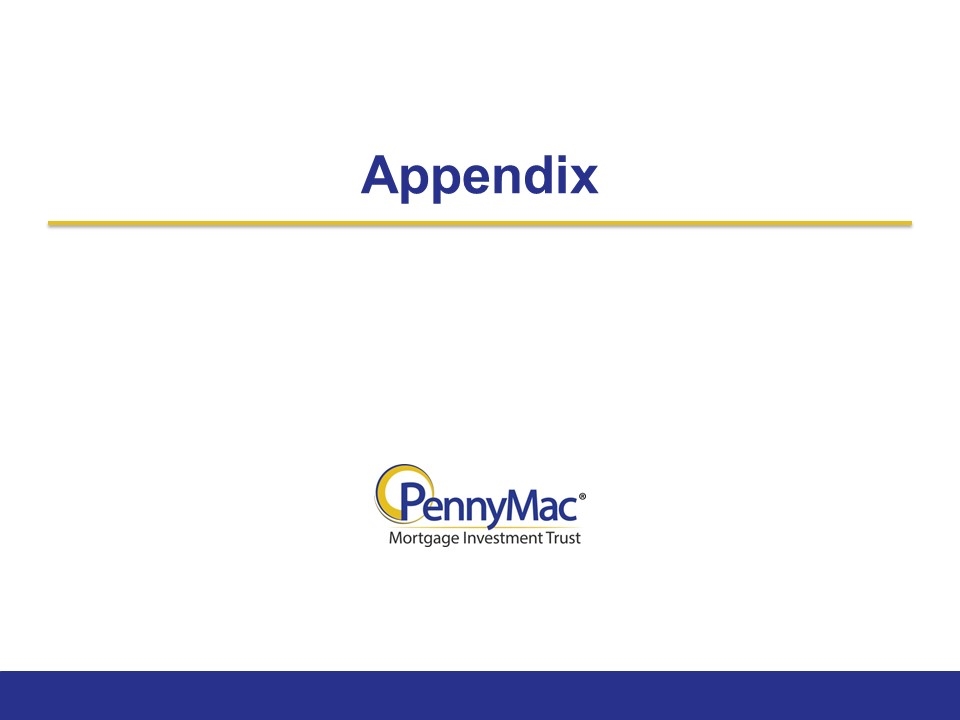
Appendix
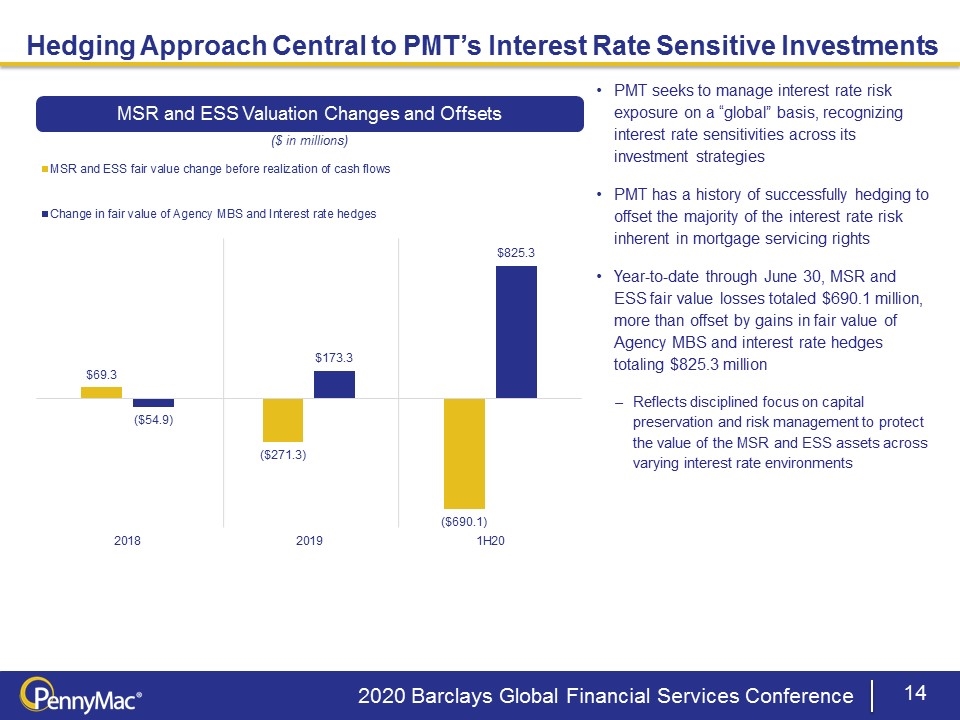
2020 Barclays Global Financial Services Conference Hedging Approach Central to PMT’s Interest Rate Sensitive Investments PMT seeks to manage interest rate risk exposure on a “global” basis, recognizing interest rate sensitivities across its investment strategies PMT has a history of successfully hedging to offset the majority of the interest rate risk inherent in mortgage servicing rights Year-to-date through June 30, MSR and ESS fair value losses totaled $690.1 million, more than offset by gains in fair value of Agency MBS and interest rate hedges totaling $825.3 million Reflects disciplined focus on capital preservation and risk management to protect the value of the MSR and ESS assets across varying interest rate environments MSR and ESS Valuation Changes and Offsets ($ in millions)
